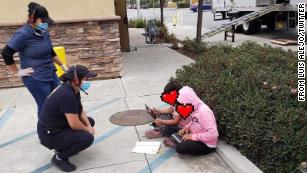The importance of addressing poverty in education

Two children outside a Taco Bell in Salinas, California using the free WiFi to do schoolwork. The poster of this image obscured the faces of these children pictured (cnn.com).

In the beginning of the COVID-19 pandemic, two children were photographed doing their schoolwork outside of a Taco Bell. They didn’t have WiFi at home so they had to sit on the side of the street to receive their public education. An education that is supposed to be free and attainable for everyone in this country is seemingly failing. The district in California was able to give those students a free hotspot, but the district was still awaiting 2500 more hotspots that needed to be given to families.
The two students are not alone, in this country’s public school system about “15 to 16 million K-12 public school students in the US live in homes with inadequate internet connection, or have devices that aren’t equipped for distance learning” (Ebrahimji). This issue has received attention during the pandemic, but lack of education for impoverished communities has been an act of negligence historically. Children who live in poverty also usually have limited access to healthcare, food, and other necessities, which makes it even more difficult to attain an education through high school. Schools allow students to learn how to think critically and discover their interests, but if students in poverty don’t have equal access to explore learning, it makes it extremely difficult for them to pursue higher education. The idea that education is a means of escaping poverty in the US is unrealistic and will remain only an idea, if no action is taken to aid this issue.
The US has always claimed to have a strong hold on education and its importance but so far the government’s reform movements have failed. The public school system has been failing “from Bush’s No Child Left Behind to Obama’s Race to the Top to Bill Gates’ Common Core State Standards to Trump’s push for school choice”(Ravitch). Often with good intentions like calling for more funding, better trained teachers, or smaller class sizes, these leaders have failed because they continue to put focus on standardized testing, competition, and the ineffective punishments students receive. This puts an even larger gap in access to education for students living in poverty because standardized testing has been shown to discriminate against these students. It’s not a reasonable metric for measuring success in a classroom, but it’s been used by the US government to determine who has learned the most. President Obama’s “Race to the Top” is a prime example of this. President Obama created a “$5 billion program [that] offered states a chance to win hundreds of millions of dollars if they evaluated teachers by the test scores of their students, closed or shook up schools with low test scores, increased the number of privately managed charter schools, and adopted the Common Core State Standards” (Ravitch). This system didn’t raise test scores and continues to fail to demonstrate the capabilities of students. So it seems illogical for the school system to continue to measure students by these parameters.
In addition to a poor education system the US often fails to acknowledge all of the issues that affect a student’s life outside of school. Almost half of the students in the US qualify for free or reduced-price lunches and are at the federal measure of poverty. But this issue could begin all the way at prenatal care and the lack of medical care that pregnant women receive to ensure that their child is born healthy. A lack of healthcare continues to be a trend throughout the life of a child in poverty which eventually affects a child’s physical or mental health. This can make it difficult to put an emphasis on school, especially if you have a chronic health condition that requires extensive care. The cost of these health necessities can also make school supplies, transportation, and more inaccessible to these kids. Food insecurity can also exacerbate access to education if a student is thinking more about how hungry they are than what math formula they are learning. Even though the reduced or free lunch program exists, it doesn’t protect students from food insecurity when they go home. For there to be impactful change to the education system, changes need to be made outside of it first.
There are of course tremendous benefits to a public school education. School provides one of the first communities in which students can make friends and meet people outside of their own family. Students spend half of their day at school so they find friends and teachers they can rely on or talk to. Education helps students develop social skills and learn to think critically and creatively. Public schools offer learning opportunities that span the width of creativity and academics, to allow students to find their interests. Ultimately, education sets up a path for students to pursue anything they want, or at least believe that they can. Where the education system fails to support students is in everything that affects their education like poverty and health care. Learning and introducing new ideas to students will never fail to be impactful. But without various other issues resolved, the system isn’t supporting the whole child, just the version of themselves they bring to school.
The education system can not change overnight or with a single reform movement. It has to change through various steps and unravel a lot of the history that the US education system is rooted in. One of the first steps is acknowledging that income inequality is one of the most important determinants of how a student will do in school, if schools continue to base success on test scores. We can also recognize that in order to combat these disparities, students and families in poverty need access to nutrition, medical care, and housing among other things. To increase stability of public schools teachers should also be compensated more and more funding needs to be allotted to public schools, especially those in more impoverished neighborhoods. Instead of focusing on standardized testing the schools could use the money to aid the students and create smaller class sizes to create more individualized learning. To ensure that all students have the proper resources they need to have access to nurses, counselors, librarians, music teachers, and many more people that can cultivate learning and allow for students to be successful as learners and not at taking tests. Students need learning in their life but the current education needs a reform, or many students will continue to be left behind without a fair education.
Works Cited
Ebrahimji, Alisha. (2020) School sends California family a hotspot after students went to Taco Bell to use their free WiFi. https://www.cnn.com/2020/08/31/us/taco-bell-california-students-wifi-trnd/index.html
Levy, Gabrielle. (2018) Rethinking Education in America. https://www.usnews.com/news/the-report/articles/2018-07-27/americas-schools-arent-working-for-americas-kids
Ravitch, Diane. (2020) The Education Reform Movement Has Failed America. We Need Common Sense Solutions That Work. https://time.com/5775795/education-reform-failed-america/

Nelly Ramos-Laguna is a senior this year and is excited to join the Lion journalism staff. At Bellarmine she enjoys being a part of the cross country team,...
